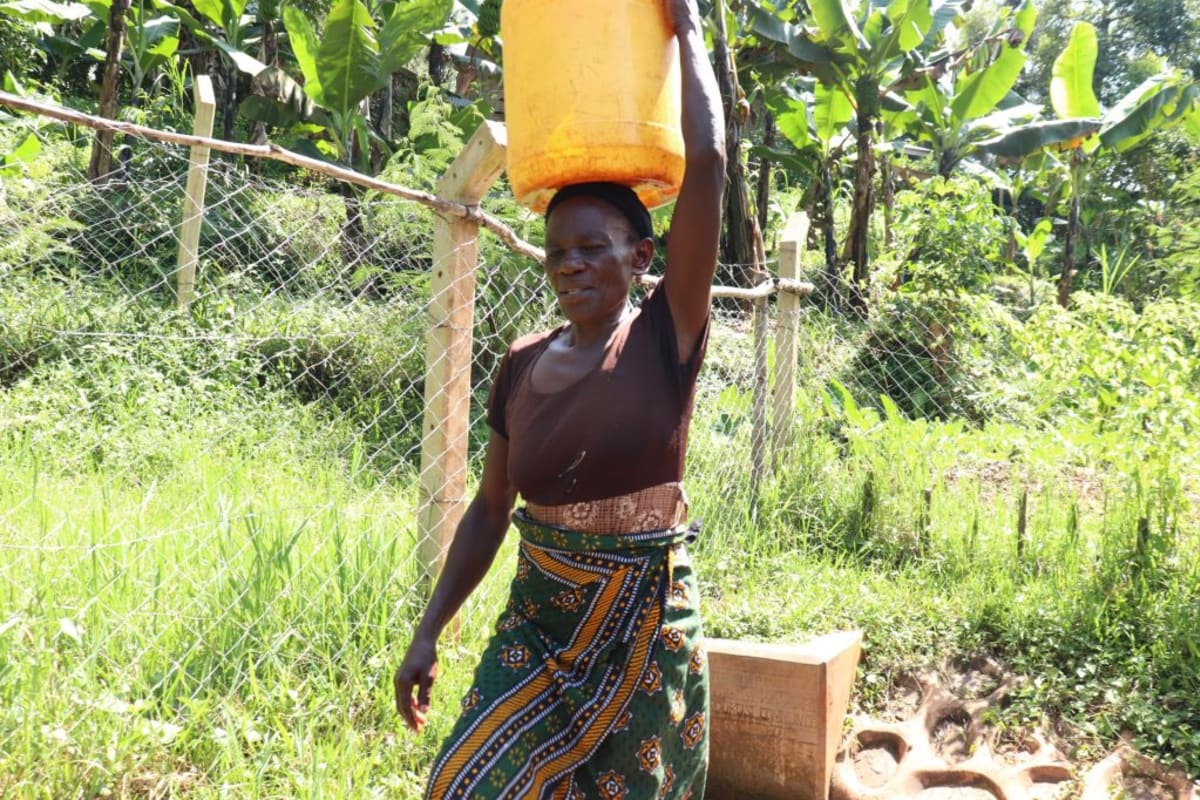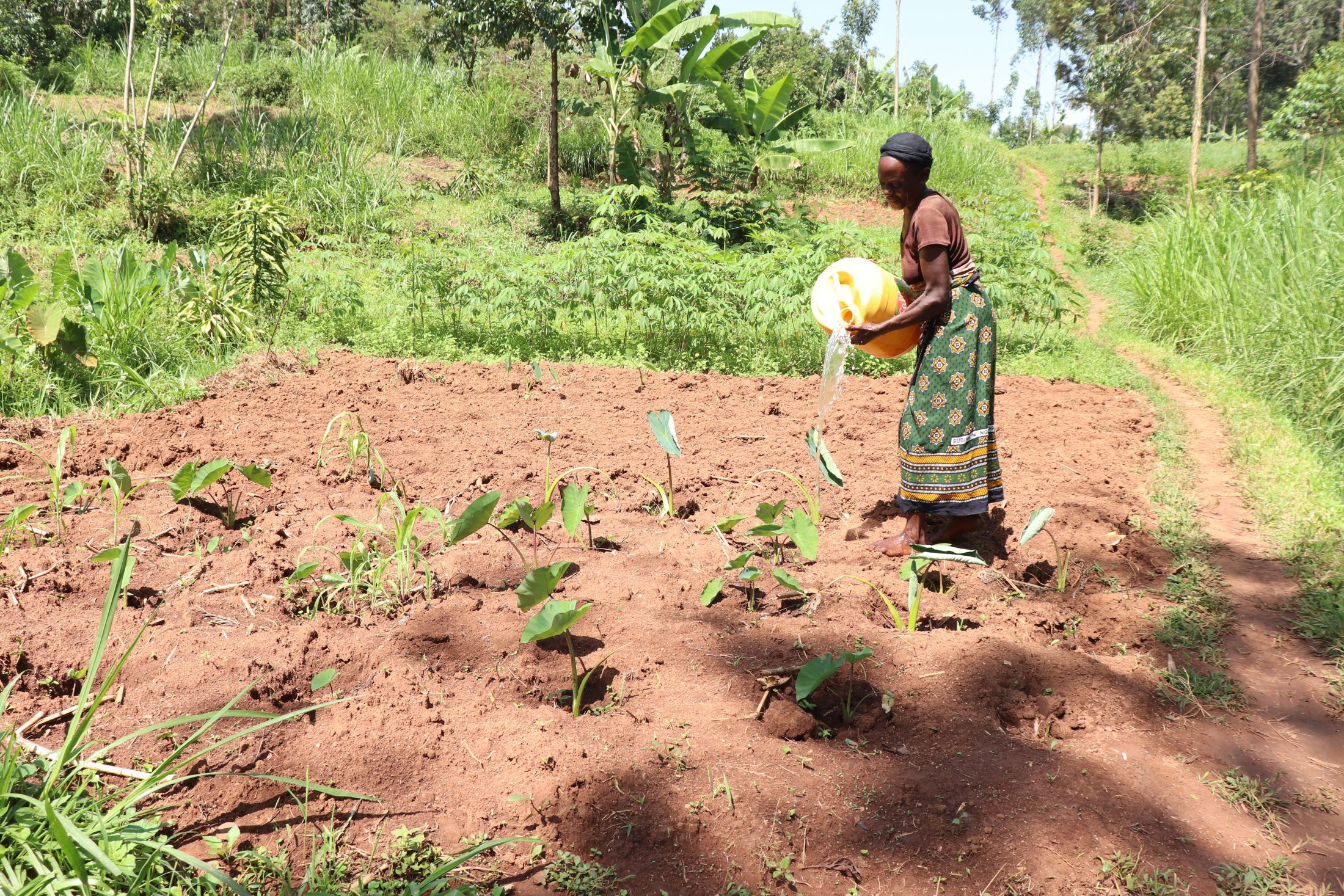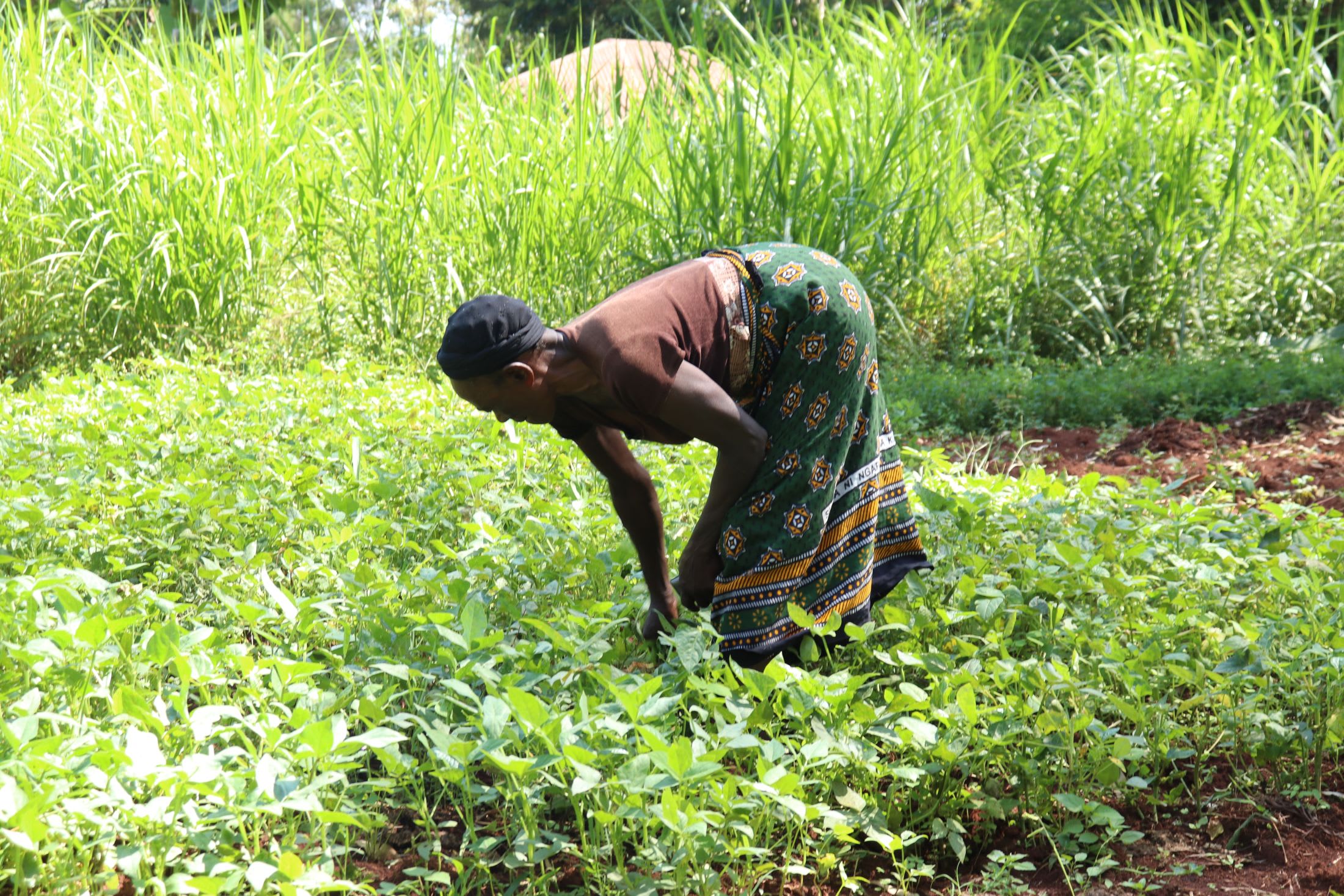April, 2023: Esiandukusi Community Spring Protection Complete!
Esiandukusi Community now has access to clean water! Thanks to your donation, we transformed Wambaya Spring into a flowing source of naturally filtered water. We also installed a chlorine dispenser to provide added protection and trained the community on improved sanitation and hygiene practices. Together, these components will unlock the opportunity for community members to live better, healthier lives.
"Clean safe, reliable water is a basic human need," said 24-year-old farmer Winnie Munagi. "Water is essential in our day-to-day life, thus we cannot do without. We all need clean, safe water to quench our thirst, wash our clothes, cook, bathe, clean our houses, and for washing our hands. This, we will now do from today. Protection of the spring will allow [us to] improve our hygiene standards, thus [creating] a healthy generation."

Winnie at the new spring.
"Water being clean and sufficient, my hygiene standards will never be compromised in any way," Winnie continued. "I will be able to bathe every day, wash my hands effectively, and always have a taste of clean water, thus not compromising my health."
Children were just as excited as adults about the new waterpoint.
"Clean, safe water has a positive impact in a community," said 16-year-old Desma S. "When a community is able to access clean, safe water for drinking, a healthy generation is raised. Having protected the spring, I will be able to access safe, clean, and sufficient water at any time of need without challenges. I foresee a reduction in sore throat complications and typhoid infections, having always been a victim."

Desma carries water from the spring.
"I am able to access and collect water within the shortest time possible," Desma said. "This will guarantee me time to perform my house chores and also create ample time for my studies. Through this, my performance in school will improve."
Preparing for Spring Protection
Community members worked together to source and carry all locally available construction materials to the spring. These included bricks, sand, stones, and fencing poles. Some people also chiseled away at large rocks to break them into gravel. Because people have to carry most items by hand, the material-collection process can take anywhere from a few weeks to months.

Community members help mix cement for the spring's construction.
When the community was ready, we sent a truck to deliver the remaining construction materials, including cement, plastic tarps, and hardware. Then, our construction artisan and field officers deployed to the spring to begin work. Individual households provided meals throughout each day to sustain the work team.
From Open Source to Protected Spring: A Step-by-Step Process
First, we cleared and excavated the spring area. Next, we dug a drainage channel below the spring and several runoff diversion channels above and around the spring. These help to divert surface contaminants away.
To ensure community members could still access water throughout the construction process, we also dug temporary channels around the construction site from the spring's eye. This allowed water to flow without disrupting community members' tasks or the construction work. Excavation created space for setting the spring's foundation, made of thick plastic, wire mesh, concrete, and waterproof cement.

After establishing the base, we started brickwork to build the headwall, wing walls, and stairs. Once the walls had grown tall enough, we began one of the most crucial steps: setting the discharge pipe. The discharge pipe needs to be positioned low enough in the headwall so the water level never rises above the spring's eye, yet high enough to allow room for the average jerrycan (a 20-liter container) to sit beneath the pipe without making contact, which prevents cross-contamination.

If we place the discharge pipe too high above the spring's eye, back pressure could force water to emerge elsewhere. Too low, and community members would not be able to access the water easily. We embedded the pipe using clay (or mortar when the clay is in short supply) and placed it at an incline to ensure water flows in the right direction.
In coordination with brickwork, we pitched stones on both sides of the spring's drainage channel. We then cemented and plastered each stone, forming the rub walls. These walls discourage people and animals from standing in that area, which could cause soil erosion and a clogged drainage area.

We then cemented and plastered both sides of the headwall and wing walls. These finishing layers reinforce the brickwork and prevent water in the reservoir from seeping through the walls. In turn, enough pressure builds in the reservoir box to push water out through the discharge pipe.
As the headwall and wing walls cured, we cemented and plastered the stairs and installed four tiles beneath the discharge pipe. The tiles protect the concrete from the falling water's erosive force while beautifying the spring and facilitating easy cleaning of the spring floor.

The final stage of construction is backfilling the reservoir box behind the discharge pipe. We cleared the collection box of any debris that may have fallen during construction. Then we redirected the temporary diversion channels back into the reservoir box, channeling water into this area for the first time. We close all other exits to force water through only the discharge pipe.
We filled the reservoir area with the large, clean stones community members had gathered, arranging them in layers like a well-fitting puzzle. We covered the rocks with a thick plastic to minimize potential contamination sources, then piled enough dirt on top to compensate for future settling.

Community members help fill the spring box.
Community members transplanted grass onto the backfilled soil to help prevent erosion. The collection area was fenced to discourage any person or animal from walking on it. Compaction can lead to disturbances in the backfill layers and potentially compromise water quality.
The construction process took about two weeks of work and patience to allow the cement and plaster to finish curing. As soon as the spring was ready, people got the okay from their local field officers to fetch water.

Completed spring.
We officially handed over the spring to mark the community's ownership of the water point. Happiness, thanksgiving, and appreciation were the order of the day, flowing in all directions.
"It is always the joy of the community members to see a project of such magnitude being installed [on] their land," said field officer Sam. "From the time of preparation to construction and completion, the community members have shown commitment to the process. They were eager to see [what] the final product [looked] like. On completion day, members gathered in numbers to witness [the] handing-over process. With jerrycans, they wanted to have a first-hand feel of the new spring. The facility was officially handed over to the community through the village elder, who gave his vote of thanks to all who took part in the process, [then] later crowned the session with a word of prayer."

Training on Health, Hygiene, and More
Together with the community, we found their preferred date for training while considering other community calendar events, such as the agricultural season and social events. We requested a representative group of community members to attend training and relay the information learned to the rest of their families and friends.
When the day arrived, facilitators Sam and Rose deployed to the site to lead the event. 13 people attended the training, including ten women and three men. We held the training at a community member's homestead under a shady tree.

We covered several topics, including community participation in the project, leadership and governance, personal and environmental hygiene, water handling and treatment, spring maintenance, dental hygiene, the ten steps of handwashing, disease prevention, and how to make and use handwashing stations.
During the leadership and governance session, we held an election for the newly formed water user committee leaders, who will oversee the maintenance of the spring. We also brainstormed income-generating activities. Community members can now start a group savings account for any future minor repairs to the spring and a cooperative lending group, enabling them to develop small businesses.
The participants were particularly impressed by the lesson on dental hygiene. Our facilitators said they were left with mouths open when they were shown how to properly brush their teeth.

Tooth-brushing lesson.
"Sanitation and hygiene are critical to health, survival, and development," said 50-year-old businessman Saul Ambungo, who was elected as the chairperson of the new water user committee.

Saul.
"This community does face challenges in providing adequate sanitation for their entire population, leaving members at risk for diseases related to water, sanitation, and hygiene," Saul continued. "[The] training conducted will help in: maintaining health; increasing lifespan; promoting personal, domestic, environmental and food hygiene practices; [and] preventing [the] transmission of diseases."
Conclusion
This project required a substantial collaboration between our staff, our in-country teams, and the community members. When an issue arises concerning the spring, the water user committee is equipped with the necessary skills to rectify the problem and ensure the water point works appropriately. However, if the issue is beyond their capabilities, they can contact their local field officers to assist them.
Also, we will continue to offer them unmatchable support as a part of our monitoring and maintenance program. We walk with each community, problem-solving together when they face challenges with functionality, seasonality, or water quality. Together, all these components help us strive for enduring access to reliable, clean, and safe water for this community.
With your contribution, one more piece has been added to a large puzzle of water projects. In our target areas, we’re working toward complete coverage of reliable, maintained water sources within a 30-minute round trip for each community, household, school, and health center. With this in mind, search through our upcoming projects to see which community you can help next!
Thank you for making all of this possible!

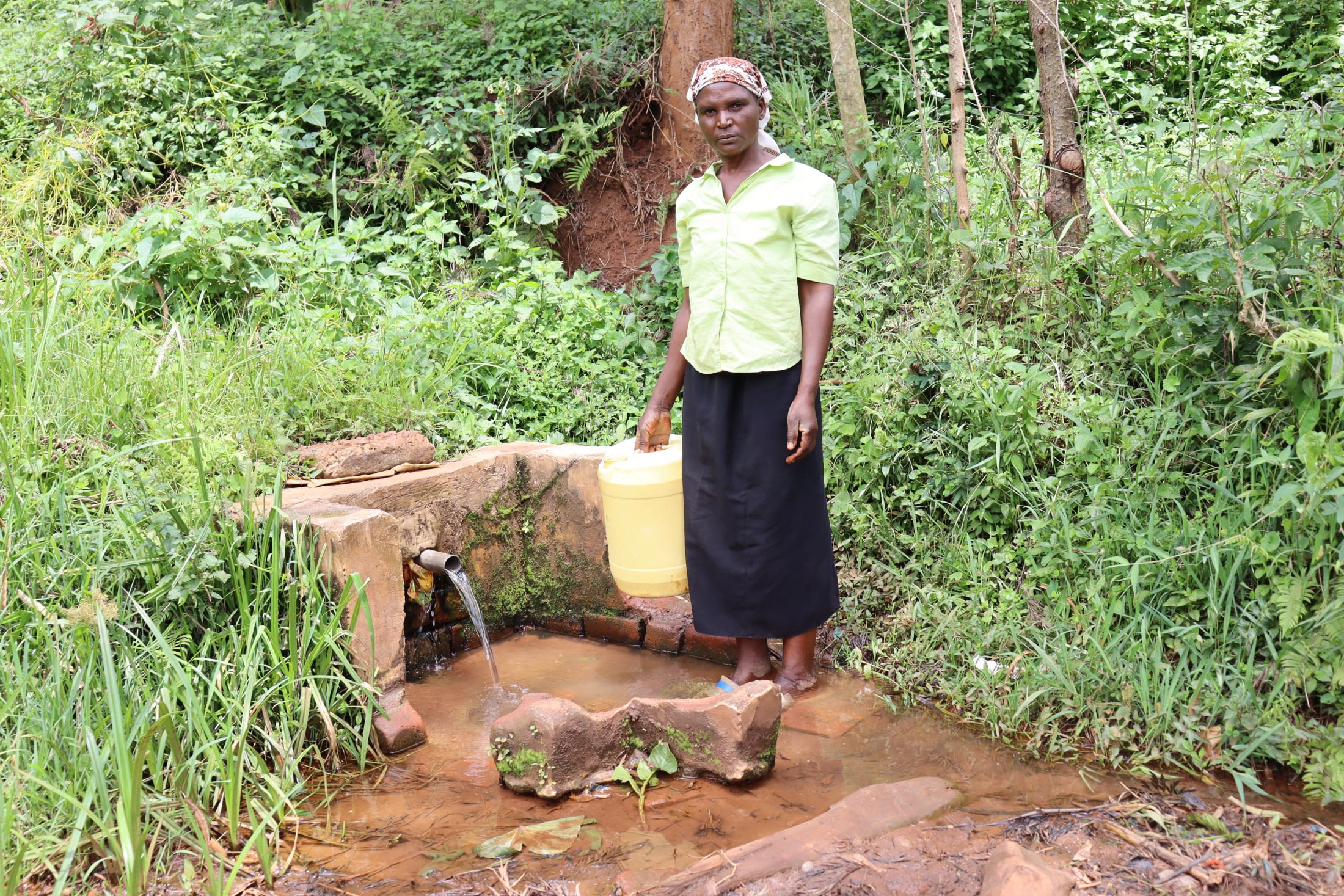
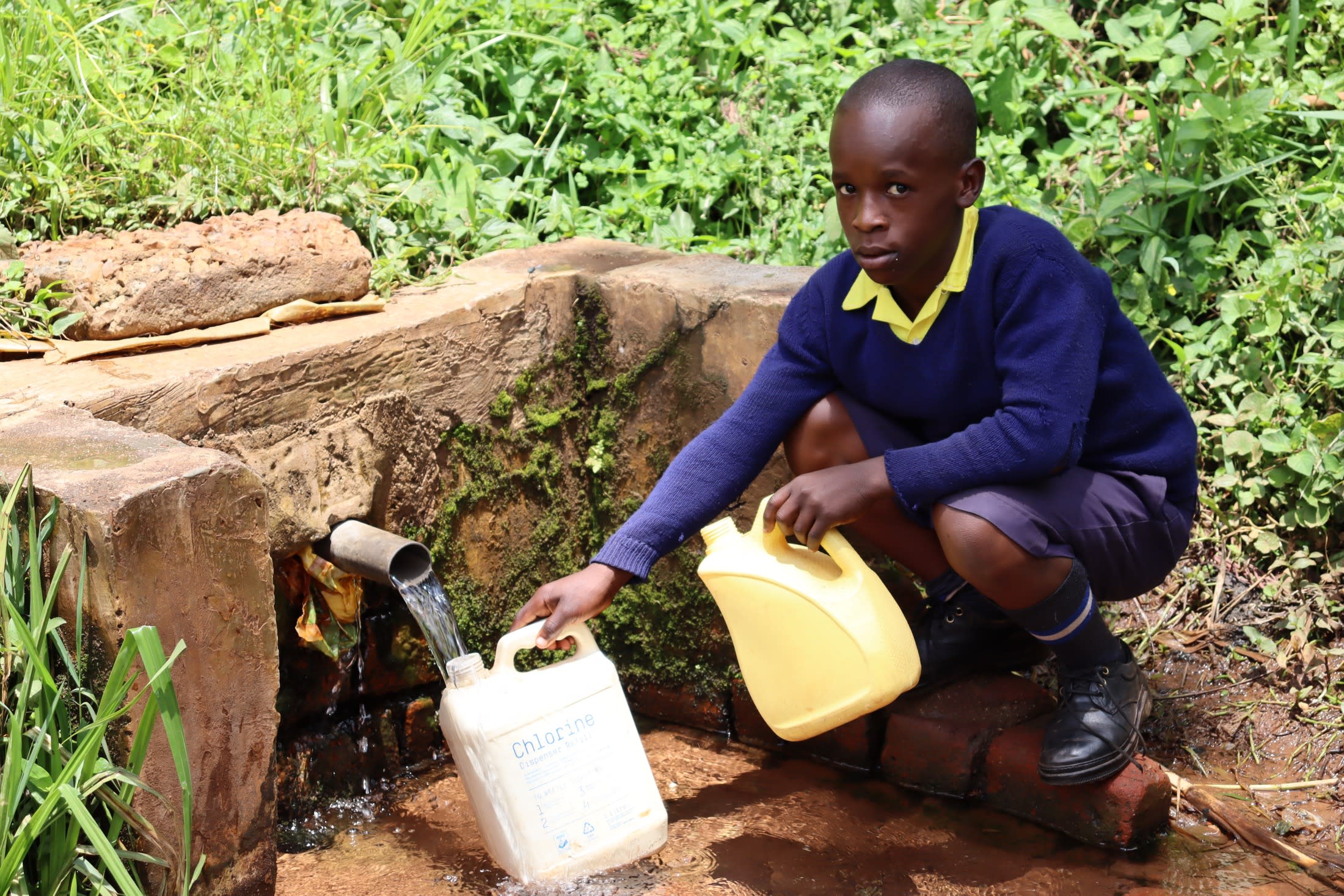



 Rehabilitation Project
Rehabilitation Project


































